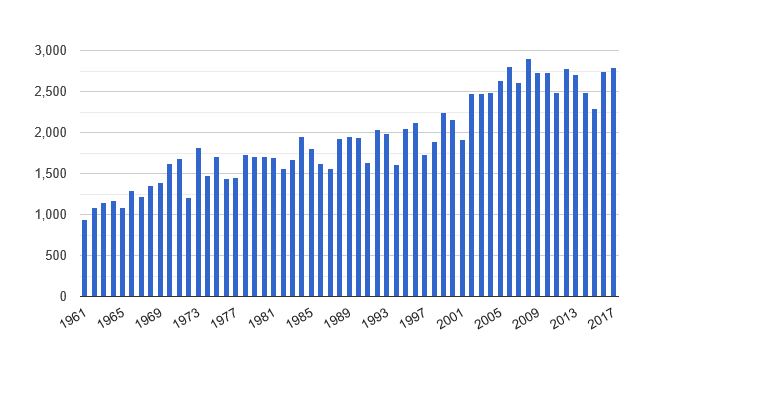An International Policy Digest (IPD) article, titled “It’s Time to Recognize Climate Refugees,” claims “refugees are … fleeing climate change.” Research shows this claim is false. Millions of people flee their homelands each year, but the causes are what they have always been war, political persecution, and poverty. Refugees now, as they always have, are leaving their countries in pursuit of a better life for their children and themselves, not climate change.
“In the face of warmer temperatures, reduced precipitation, and blighted crops—struggling farmers from Guatemala and El Salvador are giving up and fleeing to the U.S. border,” says IPD. “As the effects of climate change increase later this century, this pattern of migration will accelerate.
Also, “Climate change will submerge American communities like Isle de Jean Charles, Louisiana, and entire countries like the Maldives,” IPD claims.
The scientific evidence clearly says otherwise. As reported by, and documented in, Climate at a Glance: Climate Refugees:
- As the Earth modestly warms, there has been a reduction in climate-related refugees rather than an increase.
- The asserted causes of climate-refugees – increasing crop failures, catastrophic weather events, and islands lost to rising seas – have failed to occur.
- A majority of islands predicted to shed climate refugees due to sea-level rise are growing, not shrinking.
- Almost all nations asserted to shed climate refugees due to crop failures are benefiting from steadily increasing crop yields.
- The United Nations confirms climate-related disasters have been declining this century.
As shown in previous Climate Realism posts, here, here, and here, for example, research shows most small island nations, including the Maldives, and many parts of the American coastline are adding land mass and population rather than losing them to rising seas and emigration.
And for refugees to be fleeing Guatemala and El Salvador due to failing crops, crops actually have to be failing, which they aren’t. Instead yields have been increasing in both countries over the past few decades.
The United Nations Food and Agriculture Organization (UNFAO) provides detailed data on crop production in Guatemala and throughout the world. According to UNFAO data, charted below by the website The Global Economy, Guatemalan crop yields have been consistently improving throughout the past 50 years as the Earth modestly warms.

Figure 1: Guatemala cereal crop yields per acre by year. Source: The Global Economy, reporting data supplied by the United Nations Food and Agriculture Organization.
As you can see in the chart below, El Salvador is enjoying similarly increasing crop yields as the earth modestly warms.

Figure 2: El Salvador cereal crop yields per acre by year. Source: The Global Economy, reporting data supplied by the United Nations Food and Agriculture Organization.
In the end, IDP’s article adds to the frequent conduct of climate activists simply making things up in order to foment climate panic, and then repeating the lie over and over again until “everybody knows” it is true. Science, however, tells a different story about climate change and alleged refugees.


















Brilliant! Actual problem in Central America is likely corruption, population growth, crime. Dr. Burnett could likely add an item or two.
I’d like to know how it is possible the American continent can be adding more than a few feet of coastline per year, and how can this be enough acreage to make a difference, when you can’t have crops right on a saltwater coast?
And didn’t we just hear about South Am countries devastated by hurricanes, homes destroyed? It makes sense that people are fleeing for the same reasons they have always done so, I agree, except that now the volume has increased. It is because they know they can get into our country easier because there is little or no enforcement and the job magnet remains. Lesser-skilled U.S. workers are hurt by this. Linda Huhn Minneapolis
Sterling Burnett and others: Nice post. In Las Cruces, New Mexico we have a climate study group, Cruces Atmospheric Sciences Forum, CASF, and on our Home Page we have a feature, New Visitors, which contains this link, https://casf.me/wp-content/uploads/2019/04/The-Myth-of-America_s-First-Climate-Refugees_26_Apr_2019.pdf explores the notion that the Isle de Jean Charles Band of Biloxi-Chitimacha-Choctaw are America’s First Climate Refugees. The island is disappearing, but that island is in the mouth of the Mississippi River, and beginning with the French settlers, the river has been channelized so that the annual flood of sediment no longer covers this island nor the many islands in this locale. All river deltas are full of fine sediment which naturally settles as the water content is squeezed out. National Geographic published on this phenomenon in 1897, so it is not human-caused CO2-fueled global warming, it is the loss of the annual load of sediment from dredging and channelizing the Mississippi. Hat Tip to Willie Soon who spoke on this a number of years ago.